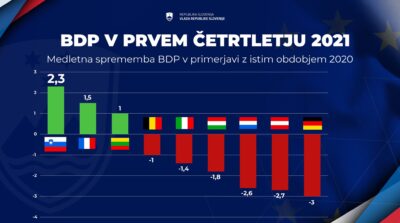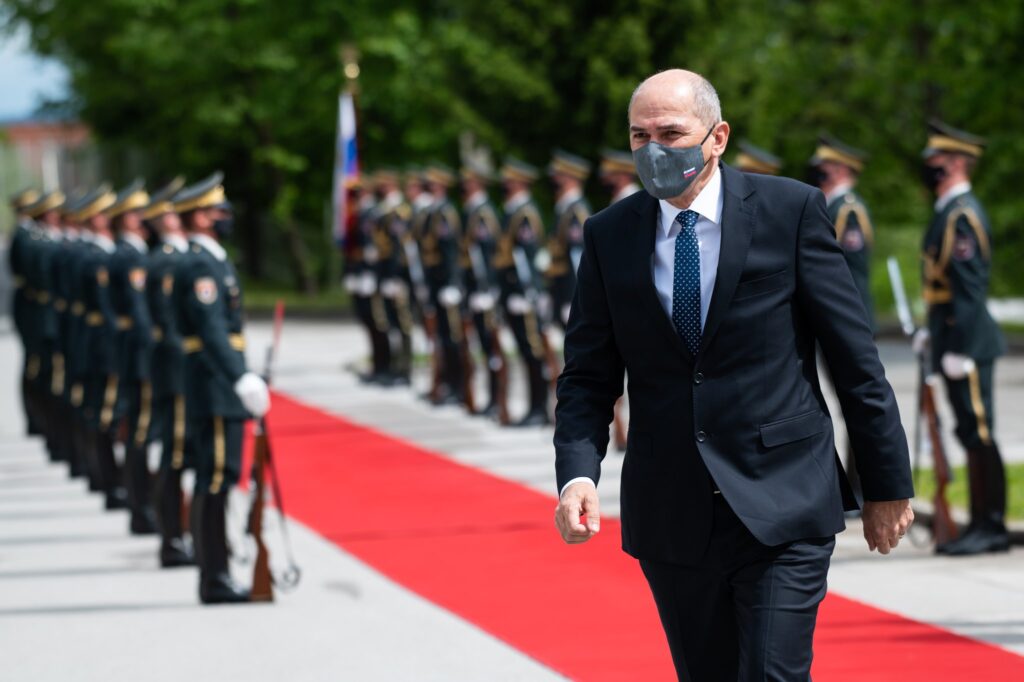In terms of GDP growth, Slovenia has recorded encouraging results, as it increased its GDP by 1.6 percent in the first quarter, despite the restrictive measures, and even achieved a 2.3 percent higher GDP than in the same period last year. Compared to neighbouring countries, Slovenia is the only country that has achieved GDP growth in the first quarter, while the other countries are still facing a fall in GDP. The fall in GDP has also been recorded in Germany, where it has shrunk by three percent. Prime Minister Janša thanked all Slovenian entrepreneurs and workers who contribute to the welfare of the state.
According to the latest data from the Statistical Office of the Republic of Slovenia, gross domestic product – GDP increased by 1.6 percent on an annual basis in the first quarter of 2021. According to the seasonally recorded data, GDP was 2.3 percent higher this year than in the same period of 2020 and 1.4 percent higher than in the fourth quarter of 2020.
Gross fixed capital formation contributed the most to GDP growth in the first quarter of 2021, while the contribution of exports and household consumption was slightly lower. Gross fixed capital formation increased by an average of 7.6 percent. Investments in machinery and equipment contributed to this the most (as they were higher by 20 percent), of which investments in transport equipment were higher by 31.7 percent and investments in other machinery and equipment by 16.8 percent. Investments in buildings and structures were 3.9 percent lower than in the first quarter of 2020.

On average, export increased by 0.8 percent and import by 0.5 percent, while so far, only the export of goods (by 4.2 percent) and import of goods (by 2.7 percent) have increased. Exports and imports of services decreased and were much lower than in the same period last year (exports by 14.1 percent, imports by 12.2 percent). Exports and imports of services declined largely due to a decline in travel and tourism. According to the Institute of Macroeconomic Analysis and Development of the Republic of Slovenia’s forecast, the second quarter will bring even more favourable prospects for economic activity in the rest of the year and a gradual recovery of the service sector.
Household consumption is slightly higher than at the beginning of 2020
The final consumption of households increased by 0.4 percent, while the final consumption of households on the domestic market decreased by three percent. The decrease was mainly due to lower household expenditure on services, which was much lower than in the first quarter of 2020. Household expenditure on other groups of goods was higher, while expenditure on durable goods increased the most, with a significant share of purchasing expenditure for cars contributing the most.
Employment fell by one percent
The number of employed people in March was similar to the previous few months. Total employment in the first quarter of 2021 amounted to 1,035,000 people, which is one percent less or ten thousand people less than in the first quarter of 2020. In the hospitality industry, various other business activities and manufacturing, employment fell the most. It has also increased in some activities, most notably in the health and social work sectors. The number of unemployed people decreased slightly in the period between February and mid-May due to seasonal factors and the easing of containment measures but remains higher than before the epidemic.
According to the newspaper Finance, year-on-year GDP growth in Slovenia was higher than in other neighbouring countries and also higher than the EU average. “In contrast to the European economy, the Slovenian economy began to recover in the first quarter of this year,” the Bank of Slovenia wrote. The outlook for economic growth in the rest of the year is strongly positive, which is why the Bank of Slovenia expects a strong acceleration in strengthening the economic activity in the second quarter. The weekly activity indicators for May indicate further growth in private consumption and exports, entrepreneurial optimism is strengthening, and consumer sentiment has improved, they explained. With the restrictions still in place due to the epidemic, in the short term, economic growth may be hampered more than demand, as many raw materials have risen in price and delivery times have been extended, they added.
The projections for the next two years are good
According to the European Commission, we can expect 4.9 percent economic growth this year and even 5.1 percent in 2022. The Institute of Macroeconomic Analysis and Development of the Republic of Slovenia’s forecast is slightly lower, at 4.6 percent for this year and 4.4 percent for the next. The Bank of Slovenia forecasts 3.1 percent growth for this year and slightly higher growth than the Institute of Macroeconomic Analysis and Development (4.5 percent) for next year.
The Prime Minister has responded to the data on Twitter, writing: “Thank you to Slovenian entrepreneurs, workers, and all those who contribute to the common good. Together we are proving that we can be among the best in Europe.”
Sara Rančigaj


